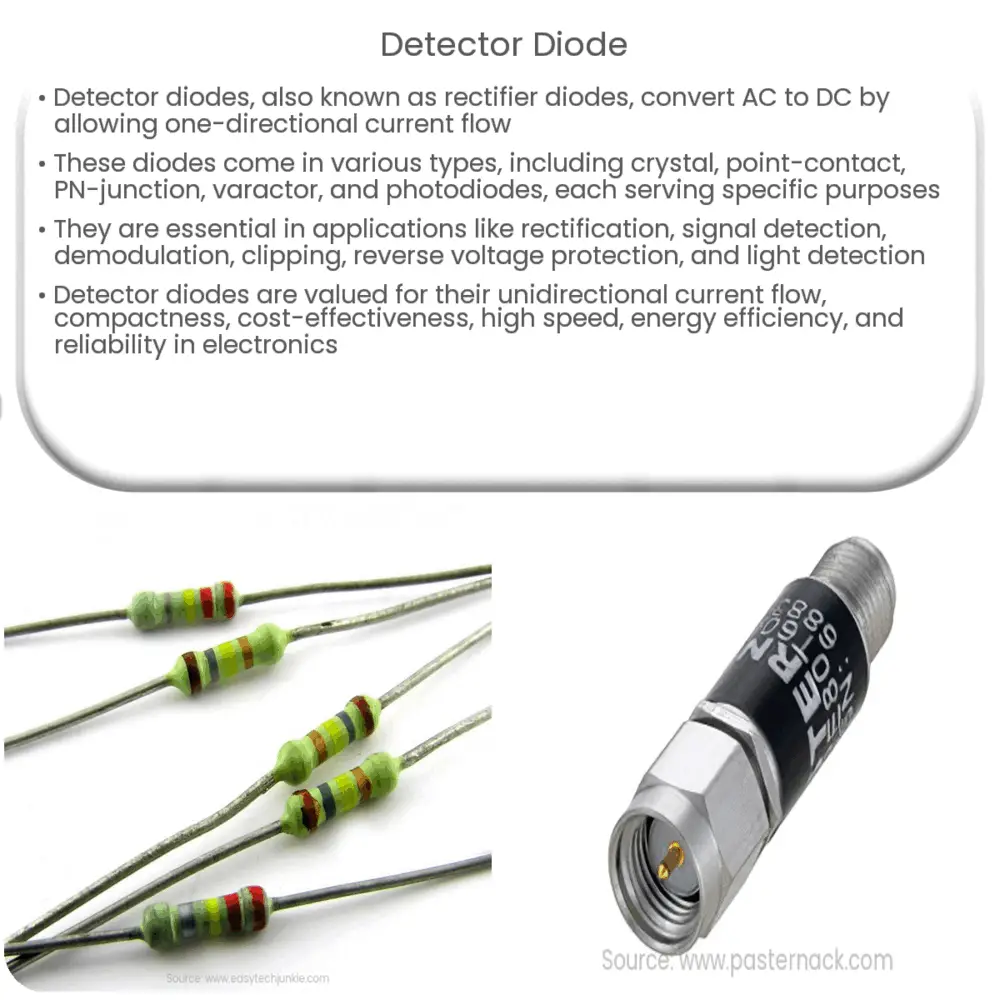A detector diode is a semiconductor device used for converting AC to DC, signal detection, and various electronic applications, offering reliability and efficiency.

Detector Diode: An Essential Component in Electronics
Introduction
A detector diode, also known as a rectifier diode, is a fundamental component in the world of electronics. It is primarily used for converting alternating current (AC) to direct current (DC) by allowing current to flow in only one direction. In this article, we’ll delve into the basics of detector diodes, their types, applications, and advantages.
Detector Diode Basics
A diode is a two-terminal semiconductor device with a distinctive asymmetrical electrical behavior. It exhibits low resistance in one direction, allowing current to flow through it, while showing high resistance in the opposite direction, effectively blocking the current. This characteristic property of diodes is called ‘rectification,’ which is the basis for their use as detectors in various electronic systems.
Types of Detector Diodes
Detector diodes come in various types, each designed for specific applications and purposes. Some of the most common types include:
- Crystal Diodes: These are simple and inexpensive diodes made from semiconductor crystals like germanium or silicon. They are often used in low-frequency applications such as AM radio receivers.
- Point-Contact Diodes: Also known as a cat’s whisker diode, these diodes consist of a thin wire in contact with a semiconductor crystal. They were one of the earliest types of diodes, primarily used in early radio and radar applications.
- PN-Junction Diodes: These diodes are made by joining p-type and n-type semiconductor materials, forming a PN junction. They are widely used for rectification, voltage regulation, and signal detection purposes.
- Varactor Diodes: These diodes function as voltage-controlled capacitors, changing capacitance based on the applied voltage. They are commonly used in tuning circuits, frequency multipliers, and voltage-controlled oscillators.
- Photodiodes: These diodes generate an electric current when exposed to light, making them suitable for light detection and measurement applications, such as solar cells and optical communication systems.
Applications of Detector Diodes
Detector diodes find applications in a wide range of electronic systems, some of which are listed below:
- Rectification: Detector diodes are used to convert AC to DC in power supplies, ensuring a steady flow of current to electronic devices.
- Signal Detection: In radio communication systems, detector diodes are used to extract audio or data signals from radiofrequency (RF) signals, enabling the recovery of transmitted information.
- Demodulation: In communication systems, detector diodes can be used for demodulating amplitude-modulated (AM) or frequency-modulated (FM) signals, retrieving the original message from the modulated carrier wave.
- Clipping and Limiting: Detector diodes can be employed as clippers or limiters in electronic circuits to prevent signal distortion by limiting the amplitude of an input waveform.
- Reverse Voltage Protection: Diodes can be used in reverse voltage protection circuits to prevent damage to sensitive electronic components from voltage spikes or incorrect power supply connections.
- Light Detection and Measurement: Photodiodes are specifically used for applications involving light detection, ranging from solar cells to optical communication systems and imaging devices.
Advantages of Detector Diodes
Detector diodes offer several advantages over other types of electronic components for various applications, including:
- Unidirectional Current Flow: Diodes allow current to flow in only one direction, making them ideal for rectification and signal detection purposes.
- Small Size and Low Cost: Diodes are compact, lightweight, and relatively inexpensive, making them suitable for a wide range of applications.
- High Speed: Diodes can operate at high frequencies, making them suitable for use in high-speed electronic devices and communication systems.
- Low Power Consumption: Diodes have low power consumption, making them energy-efficient and suitable for battery-powered devices.
- Reliability: Diodes are highly reliable and have a long operational life, making them ideal for use in various electronic devices and systems.
Conclusion
Detector diodes play a crucial role in modern electronics, with applications ranging from power supply rectification to signal detection and demodulation in communication systems. These versatile components come in various types, each tailored to specific requirements and applications. Understanding the fundamentals of detector diodes, their types, and applications can help engineers and technicians to design and maintain efficient and reliable electronic systems. The inherent advantages of diodes, such as unidirectional current flow, small size, low cost, high speed, low power consumption, and reliability, make them indispensable components in the ever-evolving world of electronics.

